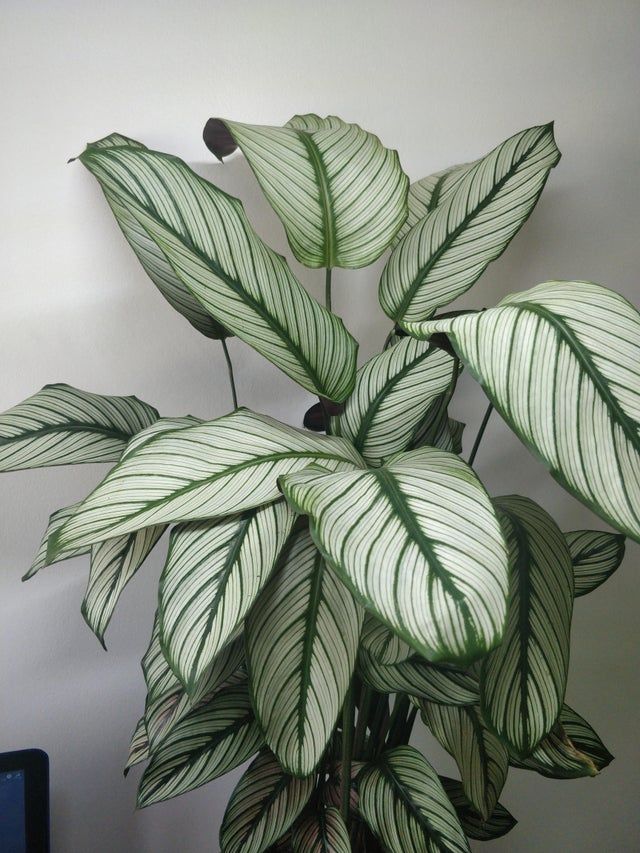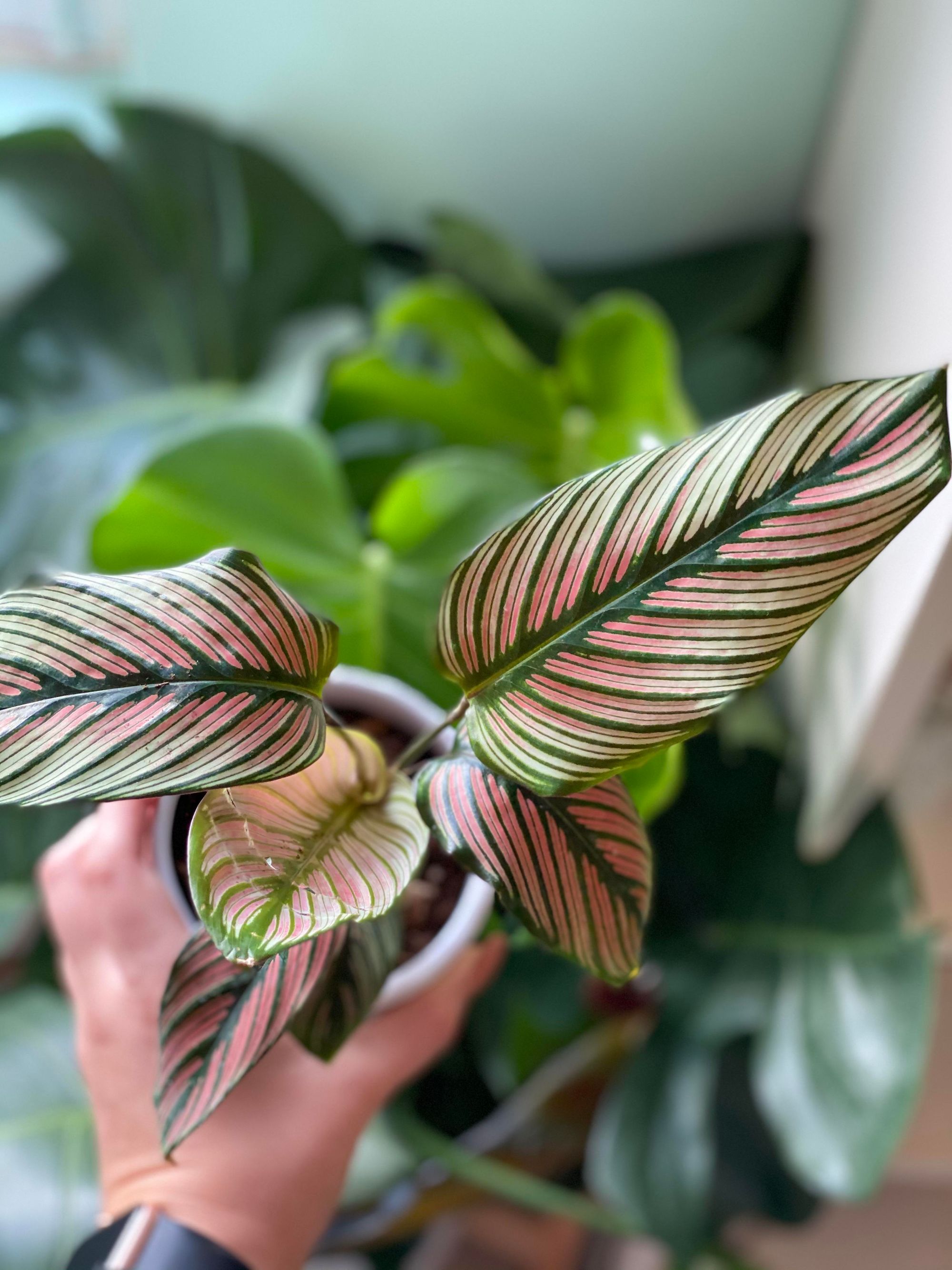How to care for Calathea Majestica Whitestar
In general most Calathea plants are known for their eye-catching leaf design and each variety has its own unique pattern. The Calathea Whitestar is a perfect example.

Other names include:
Prayer Plant, Zebra Plant.
Fun fact - The Calathea Whitestar shares the same nickname (Zebra plant) as the Calathea Zebrina (Zebra plant) - Are you confused yet?
In general most Calathea plants are known for their eye-catching leaf design and each variety has its own unique pattern. The Calathea Whitestar is a perfect example. This magnificent beauty is characterized by a contrasting appearance that leaves most people dazzled the first time they set eyes on it.
Native to the subtropics, particularly the rainforests of Brazil, the underside of its leaves are dark with deep burgundy-purple hue, whilst the upper side of the leaf possesses a lush green background with bright white stripes and faded pink patches (the pink patches are similar to another calathea variety – the calathea white fusion).
Like most Calatheas the Whitestar loves a humid environment
Remember - this is a plant that originated in the humid- tropical rain forests of south and central America, so it is important to try as much as you can to mimic this environment in your home.
To achieve this, you can either
- Buy a humidifier.
- If you don't have a humidifier, you can keep the Calathea in your bathroom especially after a shower (for a few hours) or as a last resort place a large bowl filled with water in the immediate vicinity of the plant to keep the humidity from dropping.
- Mist - put some water in an empty spray bottle (add some soap for preventative cleaning) and spray across the entire plant at least 1-2x a day.

Light Requirements: Calathea White star
This Calathea variety prefers an indirect source of light, so it's best to keep them in a partially shaded location. A few meters opposite the window or something similar will do.
In some parts of the world with less sunshine, you can keep your Calathea whitestar outside for a few hours of morning sunshine. Whatever you do however, make sure you avoid leaving the Whitestar in direct contact with the blazing midday sun. Otherwise the leaves might burn and turn crispy.
Calathea White star water requirements
Before you do anything, remember that these plants can be sensitive to harsh chemicals in tap water. So it is recommended to use distilled/filtered or rain water to avoid burned edges.
In most cases, the plant does not need a lot of water. Always check for dryness before you water the plant. You can do this by making little holes in the soil with your finger/knucles.
As soon as you can feel that the top layer of soil has dried, you can give it a little bit of water. It is also a good idea to mist your calathea with a soapy-water mix because they benefit from the resulting high humidity and it also helps reduce the risk of a spider mite infection - which calatheas are very prone to.
Calatheas come from jungle environments in south America, so if you can recreate those conditions at home - they will absolutely love you!
Are Calathea white stars rare?
Yes, Whitestar plants are very difficult to find at local plant stores. This is because many big-box retailers like Home Depot and Walmart prefer to carry the inexpensive, easy to care house plants tailored to beginner plant parents.
Also, the 'fussyness' of the Calathea whitestar does not help much either. In most cases, they require extra daily care and maintenance to keep them alive – a cost that may be too high for many nurseries and retailers.
If you are lucky enough to live in the tropical part of South America where whitestar plants are found, then you will be able to see the Calathea in abundance and for a good price too!
How do you encourage Calathea growth?
To make your whitestar plant more bushy and thick-looking, you're going to have to do some pruning and propagation which essentially grows another plant out of your existing plant. With this you can multiply the number of plants you have without actually having to buy any more!
Propagating the Calathea White star
The Calathea White star can be propagated in water or fresh potting mix depending on the maturity of its roots. Seed propagation is possible but not advised because it has a lower success rate and it takes weeks-months before you see results/failure for that matter.
We recommend propagating the Calathea plant in spring, it gives your plants the best chance at a successful propagation.
Below are quick easy steps to propagate the whitestar plant and encourage more growth!
- Carefully take the plant out of the pot and remove loose soil from the root ball.
- Seperate the sections by pulling the plant apart, make sure each part has enough roots for a successful propagation. This won't be easy, you might have to use a knife. See the video below for illustration
- Fill a small pot with potting soil and moisten it, then plant one half of the Whitestar in this pot. For water propagation fill a glass container with water and place the plant in water– the added benefit of this method is that you can really study the roots as they grow.
For illustration here is a video that demonstrates how to propagate the Calathea majestica whitestar plant.
Can you put your Calathea whitestar outside?
It depends on your region. In warmer environments (tropics) the Calathea plant can be grown outside as long as it is grown under a shade (as they do in their natural habitat). If you live in colder climates, this is not an option – Calathea plants struggle to survive at temperatures below 15c
Is the Calathea White star suitable for beginners?
Generally, Calatheas are fussy plants, so if you want to grow ANY calathea, you should have some experience with plants. Calatheas are not forgiving to mistakes. They react really badly to less than ideal conditions.
If you are a beginner that likes a challenge, then absolutely go for it. But make sure you diligently follow all Calathea care tips if you want to enjoy the plant for a long time.
Because of its marvellous leaves, the Calathea is popularly used as a gift. So if you plan on gifting this plant to anyone, make sure you inform the recipient of the special care needed by this houseplant so that there will be no disappointments!
Common Calathea Whitestar problems
-
Calathea White star brown tips
One reddit user posted an example of a Calathea whitestar plant with browning tips, see it here

You can see the top edges of the Calathea white star turning brown in the image above. Brown leaves can mean either one of two things- too much direct light or too little water.
Before making any changes, first observe the plant. Dig a knuckle in the soil, is it too dry? Try pushing a finger deeper (an inch should do) - still dry?
- If the answer is yes - then you need to water the Calathea more often.
- If the answer is no - then it means your Calathea white star is receiving too much bright light - change the position and observe.
Once the problem has been identified, cut off the brown leaves and change the location or water the plant (depending on the problem). After about 11 days everything will return back to normal. Always take notes and observe.
-
Calathea White star losing its pink colour
If your Calathea begins to lose its beautiful pink pattern and the leaves fade, this is an indication that it is receiving too much sunlight!
Yes, you read it right, too much sunlight can cause multiple symptoms in the Calathea plant. This is why it is very important to always observe and write things down about your plant. One thing to note, is that Calathea leaves also fade with age. So if it is an older plant - consider this a normal process.
-
Water stains on my Calathea plant

This is caused by using hard water and minerals like lime start to accumulate on the leaves. While this isn't harmful to the plant, it can affect its appearance. If you want to get rid of the spots, you can either switch to using distilled water or rainwater, or you can wipe the leaves down with a vinegar & a damp cloth.
Is the Calathea White star poisonous?
Nope! The Calathea Whitestar is not poisonous . Families with small children and pets can grow this Calathea with peace of mind.
Pests that affect Calathea Majestica Whitestar
Classic plant diseases rarely occur in Calatheas, but spider mites, mealybugs, and aphids are the most common pests.
One of the most important things to do when treating pest problems in Calathea Majestica Whitestar plants is to identify the pests. There are a variety of different pests that can infest your Calathea and each one requires a different treatment.
Once you have identified the pests, you can then select the appropriate treatment.
Spider Mites
Spider mites are tiny red or black bugs that feed on plant sap that can cause leaves to turn yellow and die. The come from the spider mite family (Tetranychidae) which includes around 1,200 species.
These pests can cause leaves to take on an appearance similar as if there were dust or powdery substance covering them up - which might not be good news considering how much these things love living in dark places where everyone else fears too....
Mealybugs
Mealybugs are small, white bugs that feed on plant sap. They can cause leaves to turn yellow and die. Mealybugs also produce a sticky substance called honeydew, which can attract ants. The best way to treat mealybugs is by spraying the plant with a strong stream of water . This will knock the bugs off of the plant, and they will drown. You can also use a pesticide that is specifically designed to kill mealybugs.
Aphids
Aphids are small, green or black bugs that feed on plant sap. They can cause leaves to turn yellow and die.
Treating your Calathea Majestica Whitestar with Neem Oil
If you are looking for an organic method to treat your Calathea whitestar for any of the above pests, neem oil is generally a good option. Neem oil is made from the seeds of the neem tree (Azadirachta indica), and it is effective at controlling a variety of pests, including spider mites.
If you spray the neem oil directly on the leaves, it helps against acute pest infestation. If you add it to the irrigation water, it strengthens the plant from the inside out via the roots.
To use Neem oil as a treatment for spider mites on your Calathea whitestar plant, make sure you mix it with water in a spray bottle and apply to the leaves of your Calathea plant by doing the following:
- Spray your infested Calathea Majestica thoroughly with the diluted neem oil as early as possible in the morning so that all bugs are hit. Be sure to get the water on all of the leaves.
- After that, a bit of patience is required, because the pests do not die immediately - but they stop sucking and eating.
- Repeat every few days until the pests are gone.
If possible, Neem oil should not be applied in the rain, otherwise the oil can easily be washed off and lose its effectiveness. Also avoid applying your neem oil in strong sunshine because there is a risk of burning the leaves of your infected Calathea whitestar.
If your plants are not yet or only slightly affected, you can also use neem as a preventive measure. Simply add a small amount of the oil to the normal irrigation water.
Conclusion
Calathea plants are very beautiful pieces of art, but also twice as difficult to care for. Don't beat yourself up if you get it wrong the first time with any Calathea variety – it takes a little bit of learning to master how to care for these beauties.